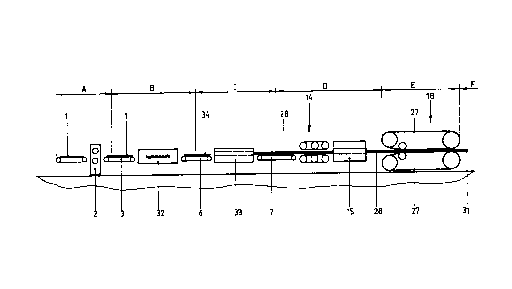Une partie des informations de ce site Web a été fournie par des sources externes. Le gouvernement du Canada n'assume aucune responsabilité concernant la précision, l'actualité ou la fiabilité des informations fournies par les sources externes. Les utilisateurs qui désirent employer cette information devraient consulter directement la source des informations. Le contenu fourni par les sources externes n'est pas assujetti aux exigences sur les langues officielles, la protection des renseignements personnels et l'accessibilité.
L'apparition de différences dans le texte et l'image des Revendications et de l'Abrégé dépend du moment auquel le document est publié. Les textes des Revendications et de l'Abrégé sont affichés :
| (12) Demande de brevet: | (11) CA 2278899 |
|---|---|
| (54) Titre français: | PROCESSUS ET USINE DE FABRICATION DE FEUILLES DE PLACAGE STRATIFIEES SANS FIN |
| (54) Titre anglais: | PROCESS AND PLANT FOR THE MANUFACTURE OF ENDLESS VENEER LAMINATES |
| Statut: | Réputée abandonnée et au-delà du délai pour le rétablissement - en attente de la réponse à l’avis de communication rejetée |
| (51) Classification internationale des brevets (CIB): |
|
|---|---|
| (72) Inventeurs : |
|
| (73) Titulaires : |
|
| (71) Demandeurs : |
|
| (74) Agent: | KIRBY EADES GALE BAKER |
| (74) Co-agent: | |
| (45) Délivré: | |
| (22) Date de dépôt: | 1999-07-27 |
| (41) Mise à la disponibilité du public: | 2000-02-08 |
| Licence disponible: | S.O. |
| Cédé au domaine public: | S.O. |
| (25) Langue des documents déposés: | Anglais |
| Traité de coopération en matière de brevets (PCT): | Non |
|---|
| (30) Données de priorité de la demande: | ||||||
|---|---|---|---|---|---|---|
|
The invention concerns a process and a plant for the
manufacture of endless veneer laminates from a strand of
veneer panels made from several layers of veneer panels
layered one above the other and one behind the other by
means of gluing and pressing in a heated, continuously
operating press, and whereby optionally the strand of
veneer panels passes through a pre-press with a preheating
device before entering the continuously operating press.
The invention consists in that several veneer panels of
manufacturing width are brought together, each overlapping
the other, and are stitched on the connecting edges into
over-width veneer panels, following which several of these
over-width veneer panels are assembled into a veneer panel
strand in layers one above the other and one behind the
other and introduced into the heating press and glued and
pressed into a veneer laminate strand. In the plant, for
the formation of over-width veneer panels (34), an
interleaving device with stitching machine (32) is located
upstream of the veneer panel laying device, while
downstream of the continually operating press (18) are
located an appropriate number of longitudinal edging and
centre cut saws.
Note : Les revendications sont présentées dans la langue officielle dans laquelle elles ont été soumises.
Note : Les descriptions sont présentées dans la langue officielle dans laquelle elles ont été soumises.

2024-08-01 : Dans le cadre de la transition vers les Brevets de nouvelle génération (BNG), la base de données sur les brevets canadiens (BDBC) contient désormais un Historique d'événement plus détaillé, qui reproduit le Journal des événements de notre nouvelle solution interne.
Veuillez noter que les événements débutant par « Inactive : » se réfèrent à des événements qui ne sont plus utilisés dans notre nouvelle solution interne.
Pour une meilleure compréhension de l'état de la demande ou brevet qui figure sur cette page, la rubrique Mise en garde , et les descriptions de Brevet , Historique d'événement , Taxes périodiques et Historique des paiements devraient être consultées.
| Description | Date |
|---|---|
| Inactive : CIB de MCD | 2006-03-12 |
| Demande non rétablie avant l'échéance | 2004-07-27 |
| Le délai pour l'annulation est expiré | 2004-07-27 |
| Réputée abandonnée - omission de répondre à un avis sur les taxes pour le maintien en état | 2003-07-28 |
| Lettre envoyée | 2000-05-04 |
| Inactive : Transfert individuel | 2000-04-03 |
| Demande publiée (accessible au public) | 2000-02-08 |
| Inactive : Page couverture publiée | 2000-02-07 |
| Inactive : CIB attribuée | 1999-09-20 |
| Inactive : CIB en 1re position | 1999-09-20 |
| Inactive : Lettre de courtoisie - Preuve | 1999-09-07 |
| Exigences de dépôt - jugé conforme | 1999-09-02 |
| Inactive : Certificat de dépôt - Sans RE (Anglais) | 1999-09-02 |
| Demande reçue - nationale ordinaire | 1999-08-31 |
| Date d'abandonnement | Raison | Date de rétablissement |
|---|---|---|
| 2003-07-28 |
Le dernier paiement a été reçu le 2002-07-26
Avis : Si le paiement en totalité n'a pas été reçu au plus tard à la date indiquée, une taxe supplémentaire peut être imposée, soit une des taxes suivantes :
Veuillez vous référer à la page web des taxes sur les brevets de l'OPIC pour voir tous les montants actuels des taxes.
| Type de taxes | Anniversaire | Échéance | Date payée |
|---|---|---|---|
| Taxe pour le dépôt - générale | 1999-07-27 | ||
| Enregistrement d'un document | 1999-07-27 | ||
| TM (demande, 2e anniv.) - générale | 02 | 2001-07-27 | 2001-07-26 |
| TM (demande, 3e anniv.) - générale | 03 | 2002-07-29 | 2002-07-26 |
Les titulaires actuels et antérieures au dossier sont affichés en ordre alphabétique.
| Titulaires actuels au dossier |
|---|
| MASCHINENFABRIK J. DIEFFENBACHER GMBH & CO. |
| Titulaires antérieures au dossier |
|---|
| FRIEDRICH B. BIELFELDT |
| MATTHIAS GRAF |